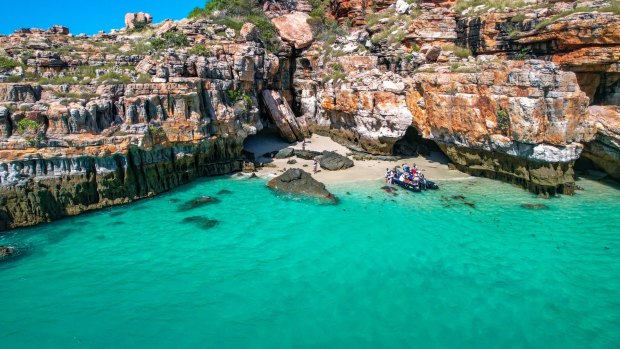This was published 1 year ago
Bigge Island, Western Australia: This island in the Kimberley is a true haven
By Nina Karnikowski

A Zodiac landing on Bigge Island.
Sweat trickles down my torso in cool rivulets, as I duck beneath the branches of a Kakadu plum tree, seeking refuge from the beating mid-morning sun. I'm trying to focus on our guide, but the still, cobalt ocean winks from the bay below. Daring me to take a dip, crocs and stingers be damned.
"Monjon, monjon!" cries our naturalist guide, a petite brunette named Juliana Restrepro, pointing wildly into the valley below like an exuberant air traffic controller. I spin around, swimming and sweating forgotten, in time to see a small brown furry creature bounce off the rocks and disappear safely into a crevasse.
Restrepro is thrilled. Monjons - the smallest rock wallaby species, that was only discovered in the 1970s and that is endemic to this northwest region of the Kimberley - are usually only seen in the early morning and late at night. We're lucky, she says. And now I'm paying attention.
We're six kilometres from the Australian mainland on Bigge Island, the largest of the Bonaparte Archipelago's islands. Forty thousand years ago, however, before the last Ice Age, this island would have been mainland. "Because of that, there's a lot of the same fauna as the mainland," says Restrepro. "But being an island, invasive and feral species haven't made it here, so it's a natural wildlife refuge."
The more time we spend on Bigge Island, the more I realise what a true haven it is. A few minutes later, Restrepro points into the rugged gully where the monjon vanished, to a long, curved line of carefully placed rocks. "These rocks would have likely been a ceremonial site, probably for men's business, for the local Wunambal Indigenous people."
Similar rock formations exist all over the Kimberley, she says, some of them stretching up to 25 kilometres long. "They usually lead from one place of cultural or spiritual significance to another, but this one could have led to a fresh water source, or to the rock art site we're about to see."
We follow Restrepro down dusky pink, quartz-rich sandstone boulders and over patches of darker grey dolerite, to a stand of tangled mangroves. The ground around them is covered in holes and prints – tiny mounds of burrowed sand from ghost crabs, tracks from monjons and northern quolls, and from birds with toes as thin as brushstrokes.
Progress is slow in the heat, but soon Restrepro gathers us around the mouth of a sandstone cave. The entrance is painted with an imposing white figure with haloes of ochre and white around its head, large dark eyes, and no mouth.
This is the first I've seen of the Kimberley's famous Wandjina art, which depicts ancestral beings that travelled through this region during the Dreamtime. The orbs around the head represent clouds, we're told, since Wandjina are responsible for bringing the wet season rains, and therefore for all creation.
Peeling backpacks and hats off our sweaty bodies, so as not to scrape the walls and the ancient art, we enter the cave. We marvel at an enormous serpent snaking above our heads, more powerful Wandjina figures, ochre handprints, and a boat filled with people.
"If you look closely, you can see these figures have neck ties, and also oar locks, so we know that this image is depicting this area's first contact with European tall ships," says Restrepro. Whether the figures are the Dutch, English or Portuguese sailors of the 1600s, or French sailors from the early 1800s, however, we'll likely never know.
I could stay and admire this art for hours, pondering its mysteries, and envisioning how life might have been for the Wunambol people thousands of years ago. But our time on Bigge Island is up. This day isn't getting any cooler. And our own ship awaits.
THE DETAILS
CRUISE
APT's 10-day Grand Kimberley Coast cruise, from Broome to Darwin (or reverse) aboard the MS Caledonian Sky, is from $10,995 a person, twin share. See aptouring.com.au
MORE
Traveller.com.au/western-australia
Nina Karnikowski travelled as a guest of APT
Sign up for the Traveller Deals newsletter
Get exclusive travel deals delivered straight to your inbox. Sign up now.